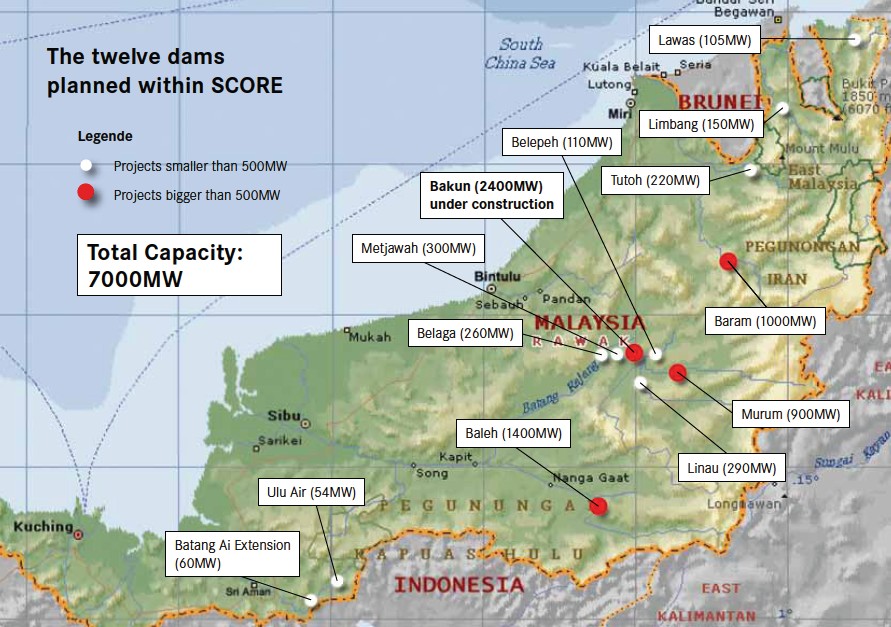Indigenous Peoples Say No to ‘Disaster Development’ in Sarawak
Ahni
Intercontinental Cry
stop-corruption-dams.com
It’s no mere coincidence that Sarawak is one of the most impoverished states in Malaysia. For more than 30 years the governments of Malaysia and Sarawak have been far too busy ransacking the region’s precious rainforest to secure and strengthen what has been there for thousands of years.Development in Sarawak has always been about making money; and as any real capitalist knows, the more money you have to spread around, the less you have for your self and your friends and family.
Sarawak Chief Minister Abdul Taib Mahmud knows this well. Minster Taib–a man whose name has become synonymous with corruption–has made a fortune at the expense of the land and people of Sarawak.
He has no intention of holding back either. Indeed, Taib wants to make sure that the decimation of Sarawak continues for decades to come…
The government of Sarawak is going all out for a new mass-industrialization project known as the Sarawak Corridor of Renewable Energy (SCORE) initiative (www.sarawakscore.com.my). Under SCORE, the government intends to build at least twelve new hydro dams in Sarawak in order to provide 28,000 MW of electricity for a yet-to-be-determined industrial complex in Sarawak.
Describing the risks of SCORE, the Bruno Manser Fund (BMF) says,
“The ecological consequences of the new dams would be disastrous. River and forest landscapes which exist nowhere else in the world apart from Borneo would be destroyed for ever, and the animal and plant world would be threatened. Apart from that, dams cause the emission of large quantities of greenhouse gases, which fuel climate change even further.”
A Switzerland-based NGO, the Bruno Manser Fund is leading a campaigning against the SCORE initiative in coordination with a coalition of NGOs from around the world.
Locations of the twelve dams planned within SCORE. Map courtesy of BMFThe social and cultural consequences of SCORE would be equally disastrous, says BMF. For instance, just one of the proposed dams–the 1000 MW Baram dam–would drown approximately 412 km2 (41200 hectares) of rainforest and 26 indigenous villages along with it. That will result in the displacement of up to 20,000 people.
Speaking to the future, Peter L., a Kenyah whose village would be lost to the Baram dam, compares the Chief Minister’s plan to “A tsunami created by human beings” that will “pick up speed and destroy everything: rivers, forest, harvest, villages, simply everything!”
“It is, however, not only the forest and fields as the lifeblood of Baram culture that are threatened,” reiterates BMF campaigner Annina Aeberli, in the NGO’s 2012 newsletter, Tong Tana. “The indigenous peoples of the Baram region are also lamenting the loss of their history and their social cohesion, which it defined strongly through their ancestors.”
As Maria, another Kenyah from Long Anap said to BMF, “Those of us alive today can at least run away when the water comes, but what are the dead going to do?” Thomas M., retired secondary teacher from the village of Long San, echoes Maria’s concerns. With tears in his eyes, he said, “my father died in 2002. I won’t let it happen that they flood his grave, so that my father dies a second time. I’m going to fight against the dam.”
Knowing the history of ‘disaster development’ all too well, Indigenous Peoples throughout Sarawak are coming together for the sake of their ancestors and future generations. Under the banner of “Save Sarawak Rivers” (SAVE Rivers), affected Indigenous Peoples like the Kenyahs, Ibans, Penans, Bidayuhs and Ukits have joined with local organizations and concerned individuals to halt the construction of the hydro dams and any other plans to bring ‘dirty industries’ to Sarawak.
Last month, SAVE Rivers hosted a landmark conference to discuss the situation.
During the three-day event, Indigenous representatives described how the Sarawak government and project companies have been denying their rights to information and consultation; how involuntary resettlement has made them more impoverished; and how other dams in Sarawak have violated international agreements like the UN Declaration on the Rights of Indigenous Peoples as well as basic rights guaranteed under Malaysian law.
After the discussions came to an end, the representatives issued a joint statement demanding an immediate end to the dam projects, respect for the right to consultation and a public referendum on the issue of the dams. They also called on the government to stop all other destructive development activities in Sarawak and to start promoting socially and environmentally responsible alternatives such as micro-hydro, solar, wind and biomass energy projects.
Following the successful conference, Peter Kallang, chairperson of SAVE Rivers, said that it’s just the beginning of the struggle. Discussing the next steps, Mr. Kallang commented, “There is a need for further awareness raising in society as such, but especially in the affected regions. Therefore, we are planning a road show in Baram where we will visit all affected communities. The goal is to create committees in all affected areas which in turn will become the organizational base for collective action against these mega-dams.”
After that it’s anybody’s guess. But you can be sure that they will not stand down,much like the popular Xingu Forever Alive movement which has been fighting the Belo Monte Dam since the 1960s. With so much at stake, there is simply no room to let the government do whatever it wants like it’s just another day at the office..
